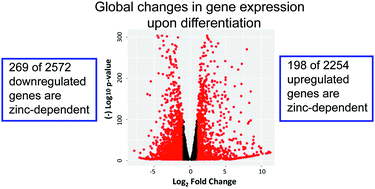当前位置:
X-MOL 学术
›
Metallomics
›
论文详情
Our official English website, www.x-mol.net, welcomes your
feedback! (Note: you will need to create a separate account there.)
Remodeling of Zn2+ homeostasis upon differentiation of mammary epithelial cells.
Metallomics ( IF 2.9 ) Pub Date : 2020-01-17 , DOI: 10.1039/c9mt00301k Yu Han 1 , Lynn Sanford 1 , David M Simpson 1 , Robin D Dowell 2 , Amy E Palmer 1
Metallomics ( IF 2.9 ) Pub Date : 2020-01-17 , DOI: 10.1039/c9mt00301k Yu Han 1 , Lynn Sanford 1 , David M Simpson 1 , Robin D Dowell 2 , Amy E Palmer 1
Affiliation

|
Zinc is the second most abundant transition metal in humans and an essential nutrient required for growth and development of newborns. During lactation, mammary epithelial cells differentiate into a secretory phenotype, uptake zinc from blood circulation, and export it into mother's milk. At the cellular level, many zinc-dependent cellular processes, such as transcription, metabolism of nutrients, and proliferation are involved in the differentiation of mammary epithelial cells. Using mouse mammary epithelial cells as a model system, we investigated the remodeling of zinc homeostasis during differentiation induced by treatment with the lactogenic hormones cortisol and prolactin. RNA-Seq at different stages of differentiation revealed changes in global gene expression, including genes encoding zinc-dependent proteins and regulators of zinc homeostasis. Increases in mRNA levels of three zinc homeostasis genes, Slc39a14 (ZIP14) and metallothioneins (MTs) I and II were induced by cortisol but not by prolactin. The cortisol-induced increase was partially mediated by the nuclear glucocorticoid receptor signaling pathway. An increase in the cytosolic labile Zn2+ pool was also detected in lactating mammary cells, consistent with upregulation of MTs. We found that the zinc transporter ZIP14 was important for the expression of a major milk protein, whey acid protein (WAP), as knockdown of ZIP14 dramatically decreased WAP mRNA levels. In summary, our study demonstrated remodeling of zinc homeostasis upon differentiation of mammary epithelial cells resulting in changes in cytosolic Zn2+ and differential expression of zinc homeostasis genes, and these changes are important for establishing the lactation phenotype.
中文翻译:

乳腺上皮细胞分化后 Zn2+ 稳态的重塑。
锌是人类第二丰富的过渡金属,是新生儿生长发育所需的必需营养素。在哺乳期间,乳腺上皮细胞分化为分泌表型,从血液循环中摄取锌,并将其输出到母乳中。在细胞水平上,许多锌依赖性细胞过程,如转录、营养物质代谢和增殖,都参与了乳腺上皮细胞的分化。使用小鼠乳腺上皮细胞作为模型系统,我们研究了用催乳激素皮质醇和催乳素治疗诱导的分化过程中锌稳态的重塑。不同分化阶段的 RNA-Seq 揭示了整体基因表达的变化,包括编码锌依赖性蛋白和锌稳态调节因子的基因。三个锌稳态基因 Slc39a14 (ZIP14) 和金属硫蛋白 (MTs) I 和 II 的 mRNA 水平的增加是由皮质醇诱导的,而不是由催乳素诱导的。皮质醇诱导的增加部分由核糖皮质激素受体信号通路介导。在哺乳期乳腺细胞中也检测到细胞溶质不稳定 Zn2+ 池的增加,这与 MTs 的上调一致。我们发现锌转运蛋白 ZIP14 对于主要乳蛋白乳清酸蛋白 (WAP) 的表达很重要,因为 ZIP14 的敲低显着降低了 WAP mRNA 水平。总之,
更新日期:2020-03-26
中文翻译:

乳腺上皮细胞分化后 Zn2+ 稳态的重塑。
锌是人类第二丰富的过渡金属,是新生儿生长发育所需的必需营养素。在哺乳期间,乳腺上皮细胞分化为分泌表型,从血液循环中摄取锌,并将其输出到母乳中。在细胞水平上,许多锌依赖性细胞过程,如转录、营养物质代谢和增殖,都参与了乳腺上皮细胞的分化。使用小鼠乳腺上皮细胞作为模型系统,我们研究了用催乳激素皮质醇和催乳素治疗诱导的分化过程中锌稳态的重塑。不同分化阶段的 RNA-Seq 揭示了整体基因表达的变化,包括编码锌依赖性蛋白和锌稳态调节因子的基因。三个锌稳态基因 Slc39a14 (ZIP14) 和金属硫蛋白 (MTs) I 和 II 的 mRNA 水平的增加是由皮质醇诱导的,而不是由催乳素诱导的。皮质醇诱导的增加部分由核糖皮质激素受体信号通路介导。在哺乳期乳腺细胞中也检测到细胞溶质不稳定 Zn2+ 池的增加,这与 MTs 的上调一致。我们发现锌转运蛋白 ZIP14 对于主要乳蛋白乳清酸蛋白 (WAP) 的表达很重要,因为 ZIP14 的敲低显着降低了 WAP mRNA 水平。总之,











































 京公网安备 11010802027423号
京公网安备 11010802027423号